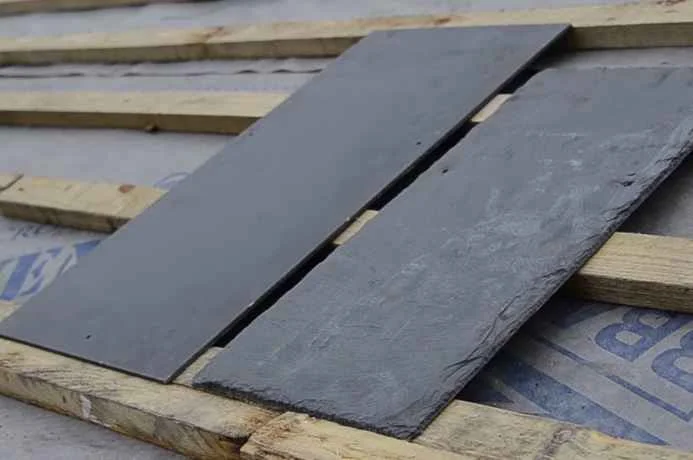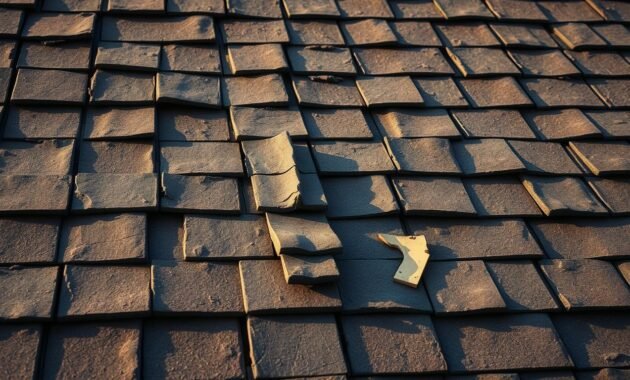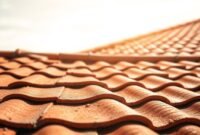Are you tired of expensive roofing solutions that drain your wallet and compromise your home’s aesthetic? Homeowners face significant challenges when selecting the right roofing material. Traditional slate looks stunning but costs a fortune, while cheaper alternatives often lack durability and style. Synthetic slate roofing emerges as a game-changing solution.
As a roofing expert, I’ve seen how synthetic slate shingles can transform homes. These innovative slate roof tiles offer the perfect balance between performance and affordability. With up to 50% lower installation costs and impressive durability, synthetic slate roofing provides homeowners a smart, sustainable alternative to traditional roofing materials.

In this guide, I’ll break down everything you need to know about synthetic slate roofing. From cost savings to design flexibility, you’ll discover why this modern roofing solution might be the perfect fit for your home.
Understanding Synthetic Slate Roofing
Synthetic slate roofing is a new way to make roofs. It’s durable and looks great. It’s different from old roofing because it uses new technology.
What Makes Synthetic Slate Different
Synthetic slate is light and strong. It’s better than natural slate in many ways:
- Lighter weight reduces structural stress
- Fire resistant properties enhance home safety
- More affordable installation costs
- Longer-lasting performance compared to traditional materials
Manufacturing Process and Materials
Making synthetic slate mixes polymers and rubber. It’s made to look and feel like real slate but with new tech.
| Material Characteristic | Synthetic Slate Performance |
|---|---|
| Durability | 40-50 years lifespan |
| Cost per Square Foot | $10-$20 |
| Weight | Significantly lighter than natural slate |
| Weather Resistance | Excellent protection against extreme conditions |
Modern Innovation in Roofing
The roofing world is always changing, and synthetic slate is at the forefront. It’s made from recycled stuff, making it good for the planet. It’s a smart choice for homes that lasts a long time.
The Benefits of Choosing Synthetic Slate
As a roofing contractor, I’ve seen the amazing benefits of synthetic slate roofing tiles. These new roofing options are changing how people think about protecting and beautifying their homes.
Synthetic slate offers many benefits that make it a top choice for roofs. Here are the main advantages:
- Exceptional Durability: Synthetic slate roofing can last up to 75 years
- Lightweight Construction: Much lighter than natural slate, which reduces stress on your home
- Cost-Effective Solution: It’s more affordable than traditional slate roofing
- Easy Installation: It can be installed using standard roofing nails
- Weather Resistance: It provides excellent protection against harsh weather
When you compare synthetic slate to other roofing materials, its benefits are clear. Its lightweight nature means less stress on your home and possibly lower installation costs.
| Feature | Synthetic Slate | Natural Slate |
|---|---|---|
| Lifespan | 75+ years | 100+ years |
| Weight | Lightweight | Heavy |
| Installation Complexity | Easy | Specialized Skills Required |
| Cost | Budget-Friendly | Expensive |
For homeowners looking for a practical, long-lasting roofing option, synthetic slate tiles are a smart choice. They offer beauty and performance, making them a great way to protect your home.
Cost Comparison: Synthetic vs Natural Slate
Choosing the right roofing material is a big decision for homeowners. Synthetic slate seems to offer a good balance of cost and quality. It’s a smart choice for many.
Let’s look at the cost of installing synthetic slate roofing. It costs between $10 and $20 per square foot. This includes both the materials and the labor. It’s much cheaper than natural slate.
Initial Investment Analysis
Synthetic slate is a wise financial choice at first glance. Here are some key points:
- Basic synthetic slate tiles cost between $5 to $10 per square foot
- Premium synthetic slate tiles range from $20 or more per square foot
- Labor costs typically range from $1,000 to $5,000
- Additional installation expenses like underlayment can add $200 to $1,000
Long-term Financial Benefits
Synthetic slate offers great long-term value. It’s made from recycled rubber and can handle tough weather. It lasts 30 to 50 years, saving you money over time.
Installation Cost Factors
Several things affect the total cost of installing synthetic slate. The complexity of the roof, local weather, and labor rates all play a part. It’s wise to get quotes from different contractors to find the best deal.
Choosing synthetic slate means saving money now and getting a durable, beautiful roof for years to come.
Durability and Weather Resistance

Synthetic slate roofing shingles are a top choice for protecting your home. They are made to handle extreme weather that traditional roofs can’t. They can last up to 100 years, making them a durable option.
The strength of synthetic slate comes from its advanced making. Companies like DaVinci Roofscapes use special materials. These materials help the tiles stand up to:
- High-velocity winds up to 180 mph
- Severe hailstorms
- Intense UV radiation
- Temperature fluctuations
While synthetic slate roofs cost more upfront, they save money in the long run. They need fewer repairs and replacements. This is great for places with tough weather, like Texas, Nebraska, and Kansas.
These roofs get a Class 4 Rating for impact resistance and a Class A Rating for fire resistance. They offer top-notch protection against damage. The tiles also resist cracking, splitting, fungus, algae, and insects.
Choosing synthetic slate roofing means you can relax. With the right installation and some upkeep every five to seven years, they work well for decades.
Installation Process and Requirements
Installing synthetic slate roofing needs careful planning and expert help. The light weight of synthetic slate shingles makes it easier to install than traditional materials. Knowing the main steps can help you feel more confident during the process.
Before starting the installation of slate roof tiles, several important steps must be done:
- Conduct a thorough roof deck inspection
- Ensure structural integrity can support synthetic slate roofing
- Check for any existing damage or needed repairs
- Verify proper roof pitch and ventilation
Professional Installation Guidelines
Getting a professional to install synthetic slate roofing is key. Experienced contractors use special techniques for the best results. The process includes:
- Removing existing roofing materials
- Installing high-quality underlayment
- Precise alignment of synthetic slate shingles
- Securing tiles with specialized fastening methods
Essential Tools and Equipment
| Category | Required Tools |
|---|---|
| Cutting Tools | Utility knife, roofing shears |
| Measuring Tools | Tape measure, chalk line |
| Safety Equipment | Harness, non-slip shoes, gloves |
| Installation Tools | Roofing hammer, nail gun |
With the right installation, synthetic slate roofing offers great protection and looks for years. Choosing professional installation means your roof will work its best.
Aesthetic Appeal and Design Options
Synthetic slate roofing has changed how we think about roof installations. It brings the beauty of natural slate to our homes. Plus, it offers many design choices that can make any house look amazing.
The design options for synthetic slate are amazing. Makers have created tiles that look just like natural slate. This gives homeowners lots of style choices:
- Authentic slate-like textures and patterns
- Wide color palette ranging from classic grays to rich earth tones
- Customizable profiles to match different architectural styles
- Options mimicking various slate quarry looks
When it comes to cost, synthetic slate is a great choice. It looks like natural slate but costs less. Brands like DaVinci Roofscapes and CertainTeed have made it possible to have:
- Lightweight tile designs
- Enhanced durability
- Lower overall project expenses
- Greater design versatility
Architects and homeowners love how synthetic slate fits with many styles. It works well with everything from rustic cottages to modern homes. You can pick from many colors and textures to make a roof that’s truly yours. It looks great and works well too.
Maintenance Requirements and Longevity
Synthetic slate roofing is a great choice for homeowners. It’s durable and needs little upkeep. As a roofing contractor, I’ve seen how it cuts down on maintenance compared to other roofs.
Synthetic slate lasts a long time. It can last 50 years with the right care. This is a big plus for those looking for a fire-resistant roof that’s easy to maintain.
- Recommended annual maintenance tasks:
- Visual roof inspection
- Gentle cleaning with low-pressure water
- Removing debris and checking for damage
How often you need to maintain your roof depends on your area’s weather. I suggest getting a professional to check it at least twice a year. This helps find problems before they get worse.
| Roof Type | Expected Lifespan | Maintenance Level |
|---|---|---|
| Natural Slate | 100-150 years | Low |
| Synthetic Slate | 50 years | Medium |
| Asphalt Shingles | 15-30 years | High |
Watch out for signs your synthetic slate roof needs help. Look for loose tiles, cracks, damaged flashing, or moss and algae. Finding these problems early can save you from bigger, more expensive fixes later.
By spending a little time on regular maintenance, you can make your synthetic slate roof last longer. This protects your home’s most important part.
Read also: How Long Should a Roof Last
Common Issues with Synthetic Slate Roofing
Homeowners should know about the challenges of synthetic slate roofing. These issues can affect your roof’s life. Knowing them helps you make a smart choice and plan for upkeep.
Read also: Problems With Synthetic Roof Underlayment

There are several concerns that might affect your synthetic slate roof:
- Color fading under intense sunlight exposure
- Potential impact damage from severe hailstorms
- Risk of warping in extreme heat conditions
- Potential material degradation over extended periods
When installing synthetic slate, contractors must consider your area’s weather. Some products work better in certain climates than others.
| Issue | Potential Impact | Mitigation Strategy |
|---|---|---|
| Color Degradation | Aesthetic reduction | Choose UV-resistant products |
| Impact Damage | Potential tile cracking | Select Class 4 impact-rated tiles |
| Heat Warping | Structural integrity compromise | Use high-quality manufacturer recommendations |
Choosing top-notch synthetic slate roofing from brands like DaVinci or CertainTeed can lessen these problems. Proper installation and regular care are key to a long-lasting roof.
Fire Rating and Safety Features
When you think about synthetic slate roofing, fire safety is key. Most synthetic slate products aim for the highest Class A fire rating. This means they offer top protection against fires.
Class A fire ratings are the best in roofing safety. They show the material can handle severe fires without spreading flames. Synthetic slate often uses recycled rubber and fire-retardant tech to boost safety.
- Class A rating provides the highest level of fire protection
- Materials resist fire spread and minimize damage
- Can potentially lower home insurance premiums
The cost of synthetic slate roofs might seem high at first. But the safety benefits last a long time. Some makers have created products that can handle over 1,400 degrees Fahrenheit. This is way better than materials like cedar shakes, which catch fire at lower temperatures.
When looking at fire safety, remember these important points:
- Check specific fire ratings for each brand
- Verify installation meets local building codes
- Review manufacturer’s fire-resistance certifications
Some synthetic slate products can last up to 100 years. They keep their fire-resistant qualities. This makes them a smart choice for those who value safety and long-term protection.
Conclusion
Exploring synthetic slate roofing has shown me it’s a great choice for homes. It offers benefits that traditional materials can’t match. This makes it perfect for new homes and renovations.
The cost savings are clear. Synthetic slate costs $9-$12 per square foot, while natural slate is $22-$43. These shingles are durable, lasting up to 100 years with a 30-50 year warranty.
It’s also good for the planet. Many synthetic slate products use recycled materials. This reduces harm to the environment. Plus, they’re lightweight, making them easy to install in different home styles across the U.S.
In summary, synthetic slate is a wise choice for roofing. It looks great, lasts long, saves money, and is eco-friendly. Homeowners looking for a top-notch roofing material will find it here.




